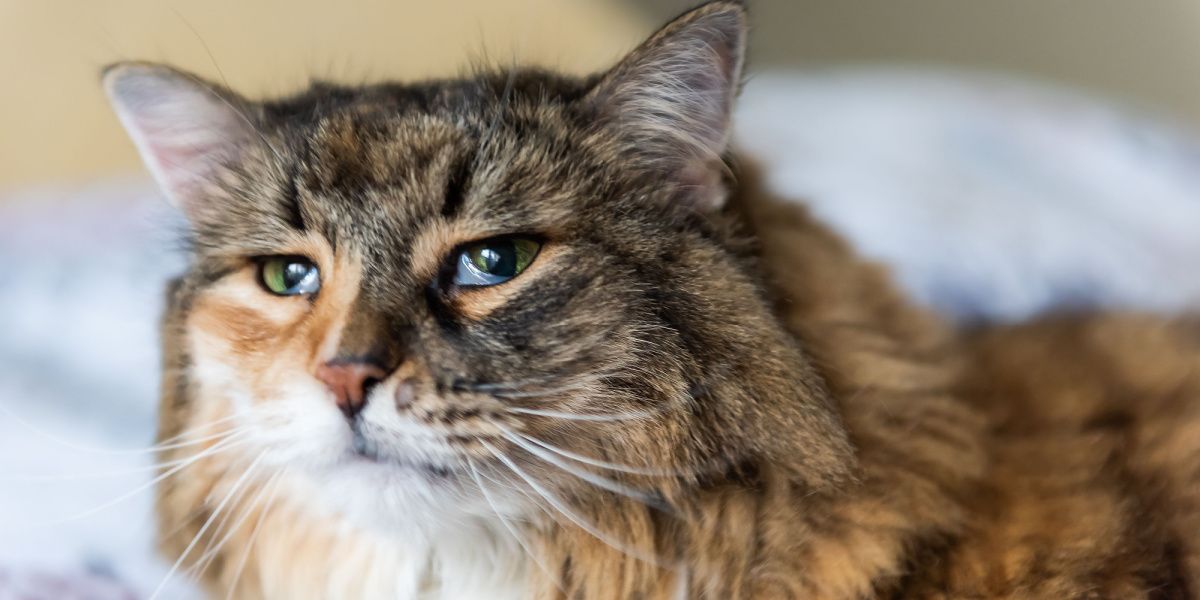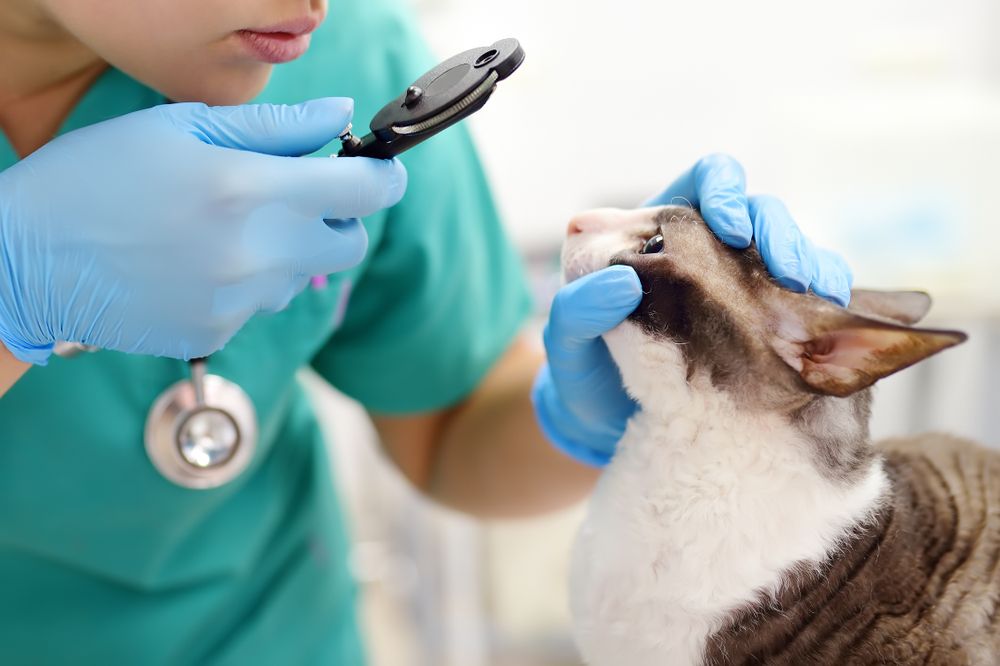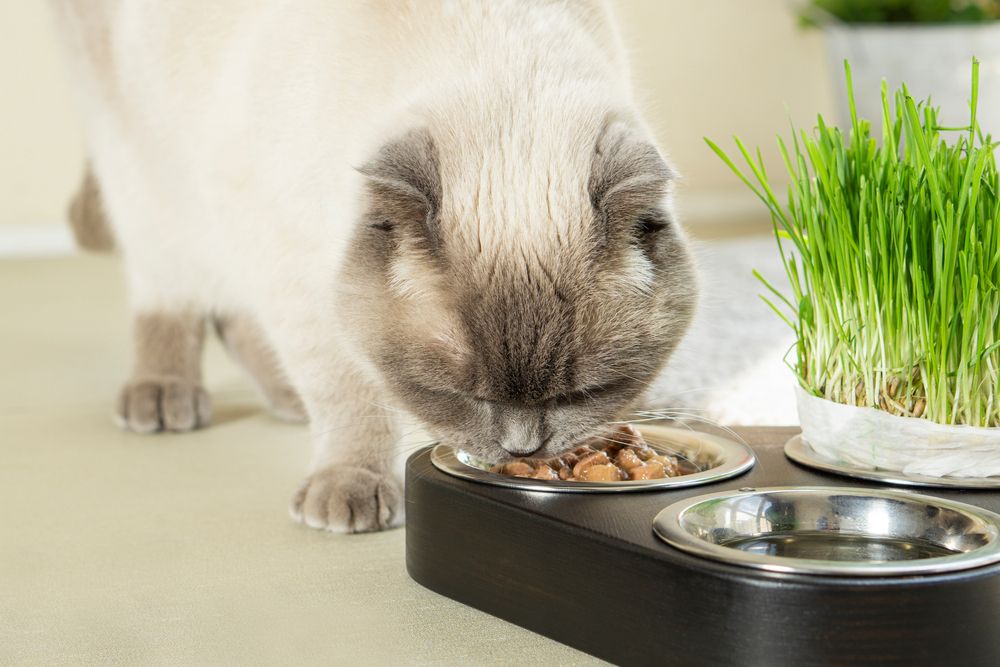
Quick Overview: Haw's Syndrome in Cats
 Other Names: Bilateral third eyelid protrusion or prolapse, bilateral nictitans protrusion or prolapse
Other Names: Bilateral third eyelid protrusion or prolapse, bilateral nictitans protrusion or prolapse
 Common Symptoms: Protrusion of the third eyelids, diarrhea
Common Symptoms: Protrusion of the third eyelids, diarrhea
 Requires Ongoing Medication: No
Requires Ongoing Medication: No
 Vaccine Available: No
Vaccine Available: No
 Treatment Options: None generally required as self-resolves; can use phenylephrine eye drops if vision obscured
Treatment Options: None generally required as self-resolves; can use phenylephrine eye drops if vision obscured
 Home Treatment: Supportive care for diarrhea if present, such as a bland diet
Home Treatment: Supportive care for diarrhea if present, such as a bland diet
Haw’s syndrome is when a cat’s third eyelids become visible across both eyes, with no other eye abnormalities.
The third eyelid (also called the nictitating membrane) is a thin white piece of tissue. You might spot them if your cat is very sleepy, or occasionally when they blink. But they should be tucked away in the corners of the eyes most of the time. If you notice your cat’s third eyelids protruding when they are alert, they might have Haw’s syndrome.
Haw’s syndrome is uncommon and tends to affect young adult cats, under two years of age. It often occurs after a bout of diarrhea – although nobody understands exactly why this is. It isn’t a painful condition, and it doesn’t cause any abnormalities in the eye itself. Haw’s syndrome generally gets better on its own, with no specific treatment, over a few weeks.
Causes of Haw’s Syndrome
The exact cause of Haw’s syndrome is a bit of a mystery. It’s thought that the third eyelids protrude because of a change in the nerves that supply that area of the eye. However, nobody knows exactly what causes this change.
It does seem to occur most frequently in cats suffering from diarrhea, due to a number of underlying inflammatory gastrointestinal conditions. Haw’s syndrome has been linked to certain parasite infections (such as tapeworm infestations) and gastrointestinal viruses. But these aren’t present in every case – and neither is diarrhea – so the exact cause of Haw’s syndrome is still unknown.
Common causes of inflammatory gastrointestinal conditions which may lead to Haw’s syndrome include:
- Gastrointestinal parasites
- Viral infections (eg. torovirus)
- Bacterial infections
- Dietary intolerances
Symptoms of Haw’s Syndrome
The only symptom of Haw’s syndrome is the protrusion of the third eyelid on both eyes, in the absence of any other eye abnormalities.
Other conditions can cause the third eyelids to become visible, including tumors, Horner’s syndrome, and trauma. Horner’s syndrome (which also causes a small pupil and a drooping upper eyelid) is often confused with Haw’s syndrome. The important difference is that in Haw’s syndrome, the eyes are completely normal, other than the protruded third eyelids.
Haw’s syndrome comes on suddenly, and affected cats have often had a recent bout of diarrhea. Some cats with Haw’s syndrome may have other signs of being unwell, such as lethargy and poor appetite. This is usually related to the underlying cause of diarrhea, such as a viral infection.
Haw’s syndrome doesn’t affect the cat’s eyesight, as the structures inside their eyeballs are normal. However, if the third eyelid is covering a lot of the eye it can obscure their vision.
Diagnosis of Haw’s Syndrome in Cats

Veterinarians will usually diagnose Haw’s syndrome in cats by performing a thorough examination of the eyes.
Your veterinarian will generally diagnose Haw’s syndrome simply by examining your cat and recognizing the characteristic signs. They will do a full ophthalmic exam (a careful inspection of your cat’s eyes) to rule out any abnormalities that might suggest another cause of the third eyelid protrusion.
Occasionally, your veterinarian may want to confirm their diagnosis by doing a phenylephrine test. They will apply phenylephrine eye drops to your cat’s eyes. If your cat has Haw’s syndrome, the third eyelids should go back to their normal position within twenty minutes. But generally, the diagnosis of Haw’s syndrome is usually done based on physical examination alone.
However, if your cat is unwell, such as with diarrhea, your veterinarian may recommend running some diagnostic tests to determine the cause. This might include blood tests, fecal analysis (including checking for parasites), and viral testing.
Treatments for Haw’s Syndrome in Cats
Haw’s syndrome is self-limiting, meaning it usually resolves on its own without any specific treatment, although a full recovery can take several weeks.
In very rare cases, the third eyelids are so far across that they obscure the cat’s vision. If this is the case, your veterinarian may recommend using phenylephrine drops to temporarily help the third eyelids to go back in. But this does not help the condition resolve any quicker, and as the condition is not painful, it is rarely necessary.
The only treatment cats with Haw’s syndrome generally need is for diarrhea if it is present. If a cause for the diarrhoea is diagnosed your veterinarian will treat this condition more specifically. But often symptomatic treatment, such as probiotics or a gastrointestinal support diet, is all they need. Your veterinarian may also prescribe a wormer, as Haw’s syndrome has been linked to intestinal parasites.
Haw’s syndrome should resolve within 6-8 weeks if any underlying cause has been treated successfully. So, if your cat’s third eyelids are still protruding after this time they should be re-checked, as they might be suffering from a different condition.
Cat Care Tips
Cats with Haw’s syndrome usually have only mild signs of illness. But there are things you can do at home to keep them comfortable and help them recover as quickly as possible, particularly if they also have diarrhea.
- Give them access to plenty of fresh water: If your cat also has diarrhea, they can lose a lot of water in their feces. Encouraging them to drink plenty will help prevent dehydration.
- Feed a gastrointestinal cat food: These diets are specially formulated for cats suffering from gastrointestinal problems. They are easily digestible and high energy and often have added electrolytes or nutrients to aid recovery. You can feed a home-cooked bland diet instead, such as chicken and rice, but this doesn’t usually contain all the nutrients your cat needs.
- Give a dose of wormer: Haw’s syndrome has been associated with parasite infections (particularly tapeworm), so discuss with your veterinarian about giving your cat a dose of wormer in case.
- Keep your cat in a safe environment: Whilst Haw’s syndrome doesn’t cause any abnormalities in the eye, it can affect their vision if the third eyelid covers a lot of their eye. So, it is best to keep them inside, in a safe environment.
- Rest them up: Cats with Haw’s syndrome often feel under the weather. So, allow your cat lots of rest and TLC at home while they recover.
Prevention of Haw’s Syndrome in Cats

Feed a complete, balanced diet to your cat and make any dietary change slowly, so as to avoid tummy upsets and diarrhea.
Nobody fully understands exactly why Haw’s syndrome happens, so it is tricky to prevent. But we do know it happens most frequently in cats with an inflammatory gastrointestinal condition, which often results in diarrhea. So, the best way to prevent Haw’s syndrome in your cat is to protect them against any conditions that may upset their gut, for instance:
- Worming: Keep your cat up to date on worming medication
- Vaccinations: Follow your vet’s advice on recommended vaccinations
- Food: Feed a consistent, high-quality diet, and ensure food is fresh and hasn’t been left out too long (particularly wet food)
- Diet change: Make any changes to their diet gradually – over seven to ten days – to avoid a tummy upset
Also Read: The Complete Guide To Feline Nutrition
Frequently Asked Questions
Can worms cause Haw's syndrome in cats?
The cause of Haw's syndrome is not fully understood. But cats with Haw's syndrome have often had a recent bout of diarrhea, which can be caused by a number of conditions - including worms. In particular, links have been made between Haw's syndrome and a heavy tapeworm infestation. However, this isn't present in every case.
Should I take my cat to the vet for Haw's syndrome?
If you see signs of Haw's syndrome in your cat you should take them to the vet. Although Haw's syndrome usually resolves on its own, there are more serious conditions that also cause bilateral protrusion of the third eyelids, such as Horner's syndrome, trauma, and tumors.
How long does Haw's syndrome last in cats?
In cats with Haw's syndrome, the third eyelid usually goes back within a few weeks. A small study showed this took an average of 47 days. If your cat is not better after 8 weeks you should re-visit your vet, as your cat may be suffering from a different condition.
Is Haw's syndrome painful in cats?
Haw's syndrome is not painful. If your cat has protruded third eyelids and seems painful you should have them checked by your veterinarian. They may be suffering from a different condition, such as trauma or a tumor behind the eye.







